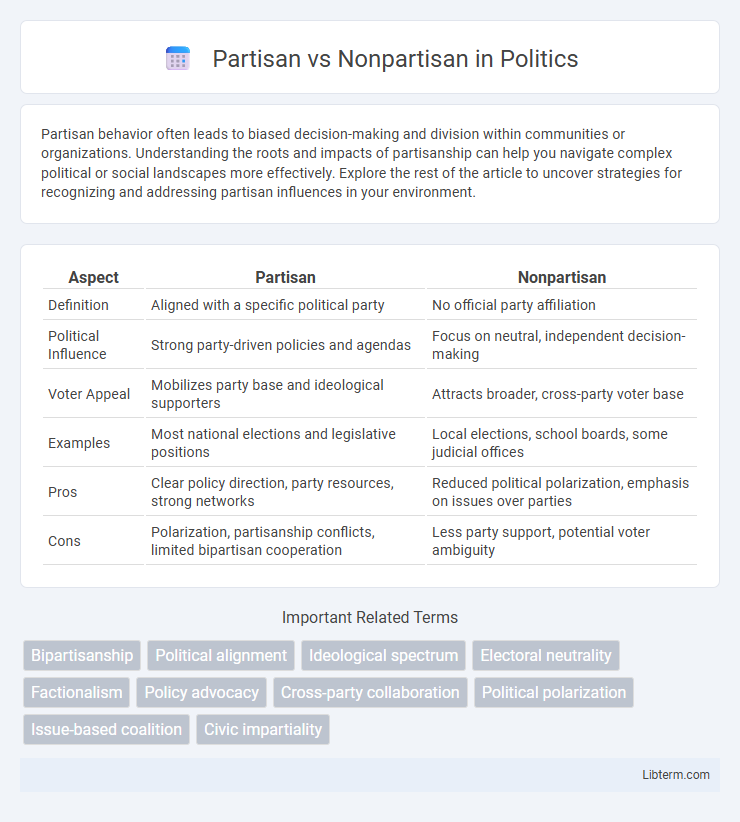Partisan behavior often leads to biased decision-making and division within communities or organizations. Understanding the roots and impacts of partisanship can help you navigate complex political or social landscapes more effectively. Explore the rest of the article to uncover strategies for recognizing and addressing partisan influences in your environment.
Table of Comparison
| Aspect | Partisan | Nonpartisan |
|---|---|---|
| Definition | Aligned with a specific political party | No official party affiliation |
| Political Influence | Strong party-driven policies and agendas | Focus on neutral, independent decision-making |
| Voter Appeal | Mobilizes party base and ideological supporters | Attracts broader, cross-party voter base |
| Examples | Most national elections and legislative positions | Local elections, school boards, some judicial offices |
| Pros | Clear policy direction, party resources, strong networks | Reduced political polarization, emphasis on issues over parties |
| Cons | Polarization, partisanship conflicts, limited bipartisan cooperation | Less party support, potential voter ambiguity |
Understanding Partisan and Nonpartisan Concepts
Partisan systems involve individuals or groups strongly supporting specific political parties, influencing decision-making and policy alignment with party ideologies. Nonpartisan frameworks emphasize impartiality by excluding formal party affiliations, aiming to prioritize objective evaluation and consensus-driven outcomes. Understanding the distinctions between partisan and nonpartisan approaches is crucial for analyzing governance models, electoral processes, and political behavior.
Historical Evolution of Partisanship
Partisanship has evolved significantly from early political factions in the 18th century to modern partisan systems characterized by ideological polarization. The transition from nonpartisan governance, where officials often prioritized consensus and local interests, to partisan politics reflects the rise of organized political parties and mass electorates during the 19th century. Historical milestones such as the formation of the Democratic-Republican and Federalist parties, and later the solidification of the two-party system in the United States, underscore the increasing role of partisanship in shaping political behavior and institutional development.
Key Differences Between Partisan and Nonpartisan Approaches
Partisan approaches align with specific political parties or ideologies, influencing decision-making through party loyalty and agenda-driven policies, whereas nonpartisan approaches emphasize impartiality and objectivity, prioritizing facts and evidence over party affiliation. In elections, partisan candidates openly declare party membership, often relying on party support for campaigning, while nonpartisan candidates focus on individual qualifications without party labels, aiming to appeal to a broader electorate. The fundamental difference lies in the role of party influence, with partisan systems fostering political competition and polarization, contrasted by nonpartisan systems that strive for consensus and reduced political division.
Advantages of Partisan Systems
Partisan systems enhance political accountability by clearly aligning elected officials with specific ideologies, making it easier for voters to predict policy outcomes. These systems often encourage greater voter participation through structured party loyalty and mobilization efforts. Furthermore, partisan frameworks facilitate efficient legislative decision-making by consolidating power within organized party groups, reducing ambiguity in policy direction.
Benefits of Nonpartisan Frameworks
Nonpartisan frameworks promote unbiased decision-making by reducing political polarization and fostering collaboration across diverse viewpoints. These systems enhance transparency and trust in governance by prioritizing merit and qualifications over party affiliations. Nonpartisan structures can lead to more effective policymaking focused on community needs rather than partisan agendas.
Impact on Elections and Governance
Partisan elections often lead to increased voter polarization, reinforcing party loyalty and influencing electoral outcomes based on party platforms rather than individual candidate qualifications. Nonpartisan elections tend to emphasize candidate merit and local issues, reducing party influence and promoting broader voter engagement with governance matters. This dynamic can result in more collaborative policymaking and less divisive governance, impacting how elected officials address community needs.
Influence on Public Policy and Decision-Making
Partisan systems often lead to policy decisions influenced by party agendas, resulting in legislation that reflects specific ideological perspectives and strengthens party loyalty. Nonpartisan approaches encourage decision-making based on objective criteria and broad consensus, reducing the impact of political bias on public policies. This can lead to more pragmatic solutions and policies that better address diverse community needs without partisan interference.
Challenges in Maintaining Nonpartisanship
Maintaining nonpartisanship challenges political institutions due to inherent biases and external pressures from partisan groups seeking influence. The blurring of lines between Partisan and Nonpartisan roles often leads to perceived or actual conflicts of interest, undermining public trust. Ensuring transparency, impartial decision-making, and strict adherence to ethical guidelines is essential to uphold nonpartisan integrity.
Real-World Examples: Partisan vs Nonpartisan Models
Partisan models often emerge in U.S. congressional elections, where candidates are explicitly affiliated with political parties such as Democrats or Republicans, influencing voter choices and campaign strategies. Nonpartisan models appear in many municipal elections, like those in Los Angeles and Chicago, where candidates run without official party labels to promote issue-focused decision-making and reduce party influence. The contrast between these models highlights how party affiliation can shape political dynamics and governance structures in different electoral contexts.
Future Trends in Political Partisanship
Emerging trends indicate a shift toward increased political polarization, with partisan affiliations becoming more deeply entrenched due to social media algorithms amplifying echo chambers. However, growing public dissatisfaction with extreme ideological divides fosters interest in nonpartisan initiatives aimed at fostering bipartisan cooperation and pragmatic governance. Data from recent polls reveal a rising number of independents, suggesting that future political landscapes may balance between entrenched partisanship and collaborative nonpartisan efforts.
Partisan Infographic

 libterm.com
libterm.com